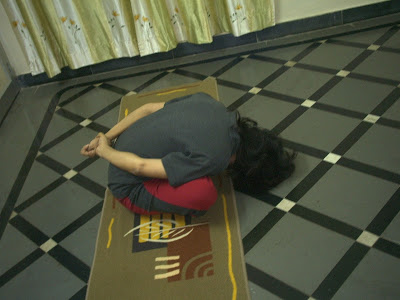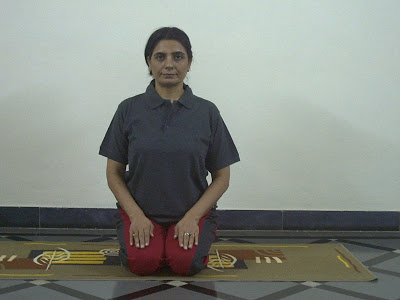By: Dr. Rita Khanna
(36 years of experience in teaching yoga)
Treating Intestinal Gas With Yoga
To satisfy hunger and taste we have invented various types of delicious food. But all loving things may not be auspicious.We may not be having the capacity to digest all food items which are tasty to the tongue.
It is not wise to eat the food which is not digestible by the body.Those who have complaints of gas should control their diet.


GAS-HOW PRODUCED & TYPES
(1) The gas produced from bacteria due to putrefaction of food.
(2) The gas produced from the chemical reaction of indigestion.
(3) The gas produced due to inadequate blood circulation in the intestine.
There are five types of gases produced in the intestine. They are nitrogen, carbon dioxide, hydrogen, methane & oxygen.
CAUSES
There are many reasons for gas formation. It occurs due to different reason in different people. It may occur due to food like potatoes, onion, milk, curd, rice, fried items, pulses, raw vegetables, soft drinks etc.Stress could be a cause too.
SYMPTOMS
With gas problem one suffers from headache, knee pain, low backache & bodyache. It could be fatal particularly for cardiac patients.
SOLUTION
AVOID
Heavy meals, pulses like channa, urad, moth and rajma, pickles and spices, fried, fatty, starchy & sugar containing food, soft drinks ,tea, coffee, cocoa, white flour, tinned fruit, refined cereals, non-veg, hot milk, raw fruit like mango, banana, late meals & gas forming foods.Avoid eating while talking, reading or watching TV.
ADOPT
Asanas such as Ardhapavanmuktasana, Pavanmuktasan, Vajrasana, Yogamudra, Halasana, Karanpidasana & Pranayamas such as Shitali, Shitkari & Sivananda. I am giving details of few Asanas & Pranayama below.
ARDHAPAVANMUKTASANA
Pavan means gas and mukta means free. Pavanmuktasana means freedom from gas. Any kind of physical abnormality that occurs due to gas can be prevented by regular practice of the Pavanmuktasana.
Lie down on your back on the mat with legs straight. Bend the right leg at knee joint & bring the knee to the chest. Interlock your fingers around the knee & press it to the thigh. Hold it for few seconds. The pressure should be felt on the belly by the leg which is bent at the knee. Then exhale & raise your head up & try to touch the knee with the forehead. Stay there for few seconds without forcing yourself. Then come back while inhaling. Do the same with the other leg. Do 3 times each side. Do same exercise with both the knees 3 times.
VAJRASANA
Vajrasana is the only asana which can be done immediately after having food. It is very good asana for digestion. Kneel on the floor. Keep the knees together. Let the right big toe overlap the left big toe. Heels apart, adjust your hips between the heels. Place your palms on your respective knees, keep the head straight & back erect. Breathe normally. Eyes closed and relax.When done, come back. Start the practice from 20 to 30 seconds and gradually increase to 15 to 20 minutes after the meals. (If there is pain in the thighs, the knees may be separated slightly in the beginning. A folded blanket or small cushion may be placed between the buttocks and the heel).
BENEFITS
By sitting in Vajrasana, the extra blood circulation is obtained in stomach by reduction in blood circulation in lower part of the body below the navel. Therefore, the working capacity of the various glands connected to digestion process increases. So there is no indigestion and as a result no gas formation.
YOGAMUDRA
Sit in Padmasana. If not possible, sit in normal comfortable position. Take both the hands behind the back and hold the left wrist by the right hand. Make fist of the left hand with left thumb inside of the left fist. First inhale & stretch the spine up.
Then start bending forward while exhaling. If possible, try to touch your forehead to the ground. Initially stay there for few breaths then gradually increase for few minutes.
BENEFITS
The regular practice of Yogamudra increases the harmony and fitness of the digestive system and it corrects all the disturbances in the abdomen. It increases the working capacity of the internal glands to a great extent.The digestion improves and there is no gas formation.
PRANAYAMA
Practice Shitali and Shitkari Pranayama in early morning & Sivananda Pranayama in the evening or when abdomen is light or empty. I have already mentioned Shitali and Shitkari Pranayama in my last Article (Balancing Weight with Yoga)
SIVANANDA PRANAYAMA
Lie on your back on the mat with your palms facing upwards. Bend both the knees. Keep the knees & feet apart.Take your mind to the solar plexus (navel)…Watch the breath… breathe in as slow as possible… breathe out as slow as possible…While breathing in, your stomach is rising… while breathing out, your stomach is falling…Remain a witness to the breath…You can practice Sivananda Pranayama for a period of ten to fifteen minutes in the morning, noon, evening as well as late night, whenever your stomach feels light, about three hours after meals.
BENEFITS
By this Pranayama, you will get mental soundness. It is very useful panacea for blood pressure, mental tension and irregularities connected with stomach.



